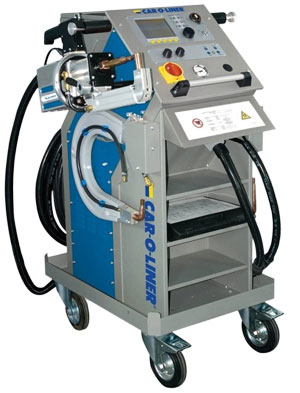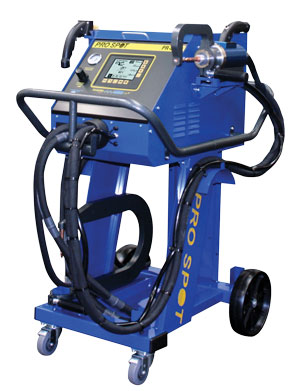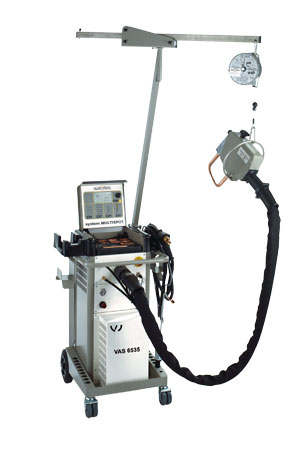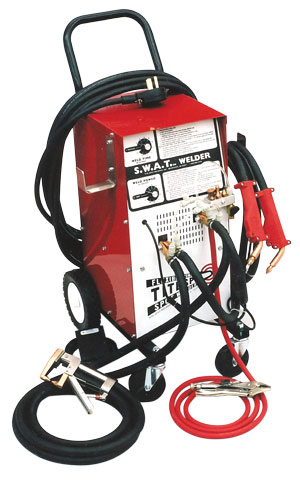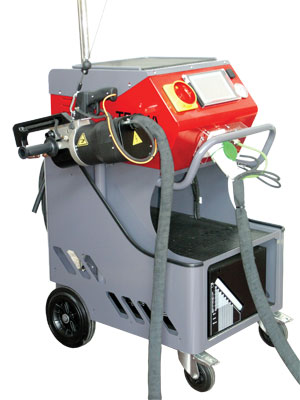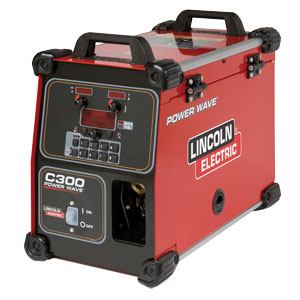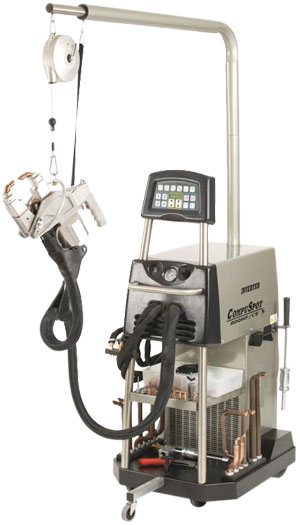The lion’s share of shop welding is done with MIG (metal inert gas). Specialty shops will use TIG (tungsten inert gas), but that’s seen mainly in bench work on street rods or motorcycle jobs. However, TIG is not recommended for collision repair as it’s a slow process compared to MIG.
Download this chart to compare different brands and models of welders.
MIG – A Necessity
“A body shop cannot survive without a good MIG welder,” says Paul Wilcox, president of Tite-Spot, Milwaukee, Wis. “Ask what machine can improve shop productivity most. When buying a MIG welder, you’re looking for infinitely adjustable power, not a tap welder with three or four settings.”
The first thing Bill Berman, president of Cebotech USA, Inc., Holly Hill, Fla., would do is to determine if the shop wants to perform structural repairs.
“If the answer is yes, then there’s only one path to follow: They must have a 3-phase inverter resistance spot welder,” he says.
This is because of the overwhelming amount of ultra high strength steels being used and the endless combinations/stack-ups of these metals.
“Look at portability, size of the components and energy efficiency. Check input power and whether you have single- or 3-phase,” says Jamy Bulan, product manager for commercial equipment with Lincoln Electric, Cleveland, Ohio. “Know what you’re trying to weld and what the material thickness is.”
Decide whether speed or quality is more important, Bulan advises. Typically, he recommends MIG, as it has no slag, the weld looks professional and it can be painted over.
“Most OEMs are recommending or mandating smart welders or at least welders with pre-programmed welding schedules,” he says.
“For shops working on aluminum cars, a pulse MIG welder is indispensible,” says Cebotech’s Berman. “I recommend a welder designed for collision repair with built-in welding programs and upgradable software.”
Power output would be tops on the list for Shawn Hart, director of technical services and training for Car-O-Liner, Wixom, Mich.
“Most of the newer metals used in vehicle construction require 10,000 amps or more to be able to produce a quality spot weld,” he says.
On top of that, he would seek upgradability. “With the advancement of materials in vehicle construction, if the welder isn’t upgradable, it will become out-of-date and may not be able to weld certain materials.”
Hart would also check how many different configurations are available with different lengths of arms, electrodes and tips to fit in the different areas of a car.
Most manufacturers have a separate line or brand of machines for MIG.
“It’s not as if today a shop is going to own a MIG welder or a spot welder,” says Ed Weihs, North Carolina-based vice president of sales and marketing for AMH Canada. “They need both for the new metals.”
Lincoln Electric’s Bulan points to a machine like their C-300 which weighs about 100 pounds and uses single- or 3-phase power as the wave of the future. It automatically changes wave forms depending on the material being welded. As new waveforms are required, they can be uploaded from the manufacturer’s website. “Your machine is not obsolete,” Bulan notes.
In addition, new units have monitoring features that allow managers to set alarms if amperage drops below a certain level.
“The machine can tell you that you’re running at the limits of the equipment. That prevents failures,” Bulan says.
Indeed, on a 30-weld job, it’s better to be warned of a problem with the first weld so it can be adjusted for the next 29, rather than to have all 30 bad.
Slick Sales
“Believe in what you want,” says Joe Fisher, CEO of Hirane Products USA. “Don’t purchase the equipment because you like the person that sells you your paint supplies. Call the main distributor of the equipment. They’ll explain it to you and arrange for
a demonstration.”
“Don’t listen too much to the salesman’s song and dance describing features and benefits of his welder,” says Ron Olsson, president of Pro Spot International Inc., Oceanside, Calif. His solution: evaluate the welder in your shop before purchasing.
OEM Approvals
“Purchasing a welder should be taken seriously, looking at OEM approvals,” says Tim Morgan, managing director-Americas for Elektron. Some OEMs have special parameters written into the software of the welder to make it perform properly.
Tite-Spot’s Wilcox says a shop owner should be certain it has circuits that will feed the welder with a minimal drop.
“Test it with an analog meter – digital meters aren’t fast enough to catch the drop,” he notes.
In the collision repair process today, there’s less MIG arc welding and greater use of resistance spot welding. In every case, pay attention to what the OEM recommends or mandates.
“TIG is too slow and requires a high degree of operator skill. It also has never been approved by any OEM that I know of,” Berman says.
MIG welding is still acceptable but has diminished application on steel-body cars. As with MIG welding, MIG brazing is still in use.
“I imagine that both will continue to be used for some time to come,” Berman says, adding that, on aluminum body cars, there’s still quite a bit of pulse MIG welding.
“TIG is too technical for the average technician,” Morgan agrees. “Stick isn’t used in unibody repair, so resistance and MIG/MAG are the welder of choice. Resistance welders save so much time in preparation and cleanup of the weld and restores the factory appearance.”
“OEMs do a lot of testing to be sure that a spot welder will work in repair for the different materials that they’re using in vehicle construction,” Car-O-Liner’s Hart says.
Purchasing a welder with several OEM approvals will help a shop conform with certification programs.
It’s safe to say that the top brands all have machines that will weld to any OEM’s specification and satisfaction.
“We can all do the job,” AMH’s Weihs says.
That’s because, basically, spot welding is about output current, weld time, tip pressure and cooling. “Everything beyond that is an enhancement like adding Dolby stereo, GPS or Sirius radio to a new car,” Weihs says. “Those things don’t make the car go faster or increase its payload. They may, however, make it nicer to handle. The key issues, he says, become, “How much is the shop going to pay for power and performance, and who’s going to provide the service?”
Tite-Spot’s Wilcox says that, while the wire and gas used are important, they’re all but irrelevant price-wise.
“You couldn’t buy a pizza for the shop on what you would save on inputs over a year,” he says. “My technique is 90 percent of the weld. The wire and gas are important, but only nominally important.”
“Spot welding wins the day,” Wilcox says, noting consumables are very inexpensive and last a long time. He recommends using a higher strength wire than the book might say. “It flows better and it’s wetter. For the fractional extra cost, it’s worth it.”
Wilcox sees the gas question the same way. Some welders use 75/25 (75 percent CO2 and 25 percent Argon). Others use pure CO2.
Older guys might remember stick welding. Some 40 years ago, it was state-of-the-art. Now, it’s almost never seen in body shops.
“In a typical environment, I wouldn’t spend the money on a TIG set-up,” Wilcox says. “They’re only useful for fussy bench work.”
In addition, TIG requires a very skilled operator…more so than MIG.
Powering Up
Most industry experts concede that Europe leads the way in welding technology and procedures.
“They’re always two to three years ahead of the United States,” says AMH’s Weihs.
Today, 3-phase is specified for everything developed there. Most U.S. OEMs (Ford, Chrysler, Toyota) have followed suit. Cebotech’s Berman says U.S. shops should, too.
“For structural collision repair, a 3-phase welder is a must. If the shop doesn’t have 3-phase power, it must get it by paying to have the power brought into the shop or paying for a power converter,” Berman recommends.
“Get 3-phase,” Lincoln Electric’s Bulan agrees. “It’s more energy-efficient. It’s the way things are moving.”
“Typically, spot welders are designed for a number of input voltages from 208-460V,” Car-O-Liner’s Hart says, adding, “3-phase is definitely the way to go.” This allows for greater power output. “Even small shops will have 3-phase power, since most spraybooth motors run on 3-phase.”
Current is always an issue in North America because the power grid is inconsistent throughout, Elektron’s Morgan says. Wiring in the facility or how close the facility is to the supply force or transformer could be issues.
“Three-phase is necessary to weld today’s materials and give enough voltage to penetrate boron and others,” Morgan says. “Single-phase welders still have many uses in the facility for non-structural welding.”
“All inverter spot welding machines have high KVA ratings, and all are subject to voltage drops when long runs from the power source are involved,” says AMH’s Weihs. The bigger and more powerful the machine, the larger the circuit requirement.
“A great deal of attention must be paid to having the proper electrical service to run an inverter spot welding machine,” Weihs adds.
U.S. power utilities these days provide power at 208-volt, 3-phase. “You have three lines; take one to ground and you get 125 volts,” Tite-Spot’s Wilcox says.
While compressors and paint booths love the 208-volt, 3-phase, welders have problems with it. “They run hotter,” Wilcox says. “The waves don’t show up quite when they should.”
In cases where 3-phase power is limited or not available, Pro Spot offers a hybrid resistance spot welder operating on batteries. The rechargeable welder can weld smaller jobs in between charges.
“This isn’t for everyone, but when primary power is an issue, it’s an alternative to resistance spot welding,” Olsson says.
Clamps
There are basically three styles of clamp that are available on welders – if you count the European trans-guns that have the transformer in the head of the gun. This design makes the unit heavier and a bit more unwieldy than the normal X-style or the G-style clamp. However, in Europe, trans-guns are important because they allow the manufacturer to control the EMF (electromagnetic field) emissions that are regulated in the European market.
In the domestic market, the X-style and G-style clamps dominate. The X-style, which is known by several names, looks like alligator clamps and offers a variety of arms. But the tech working on a quarter panel, for example, has to be in the same plane as the piece he’s working on to do the job right.
The G-style allows the technician to work perpendicular to the panel, basically at a right angle to the vehicle. While it’s user-friendly, it typically doesn’t have as many arms available.
“The trade-off allows you to reach 10 percent more of the car. Some shops prefer one style over the other,” AMH’s Weihs says. “Both will get the job done.”
Whatever the setup, have the right back-up tools. New steels require the correct tools and equipment, such as dedicated drill bits for boron and plasma cutters for cutting them.
“Make sure your technicians have tried the welder in your shop on real jobs where all the welding arms are being used,” Pro Spot’s Olsson says. “Make sure you understand how to operate the welder and change the welding arms. Many times, [repairers] find out after the purchase that the welder is too heavy or cumbersome to operate and nobody likes using it. Some welding heads are so big that, in a body repair environment, they can’t reach all areas needed to weld quarter panels.”
Aluminum
“Aluminum is at the other side of the working spectrum but it also needs careful handling,” Cebotech’s Berman says. Under the best of circumstances, aluminum is difficult to weld. “Not only is a pulse MIG welder needed, but cleanliness is of the utmost importance. Cross contamination of steel to aluminum can make it impossible to weld the aluminum. Using the correct cleaning tools and process is very important.”
Although voltages and phases are typically the same for aluminum as for steel, Tite-Spot’s Wilcox says most MIG welders designed for steel are a lousy choice for aluminum.
“If a shop wants to put aluminum in their steel MIG welder, they need to change the liner and contact tip to prevent contamination of the weld,” Wilcox says. “If shops want to use a MIG welder for aluminum, they should purchase a special welder designed for aluminum for doing just that work.”
Car-O-Liner’s Hart says his firm offers a cutter for the contact tips to re-shape and clean them for optimum use.
“They’re replaceable independent of the electrode, keeping maintenance costs down for the shops,” he says.
Hirane’s Fisher advises checking on the maximum tip pressure of double-sided air guns. He says most are 800 psi, while his 900-series unit has 500kg tip pressure (1,240 psi).
While you’re at it, check the power and weight of the gun of the spot welder under consideration. “Most are too heavy,” Fisher says.
Hart agrees that ease-of-use is key and would avoid units that are cumbersome to use and take too much time to set up. For that reason, he likes automated units that can determine material type and thickness.
“That eliminates the chance for error in machine set-up, which could affect the quality of the weld,” he says.
Elektron’s Morgan says a water-cooled unit is a must for duty cycle and proper usage.
“Water cooling to the tips and all parts of the machine will reduce the need for consumables, as tips will last longer,” he says.
In addition to water cooling that cycles through a radiator-type cooling system, a chiller can benefit the welder.
Internal Smarts
Internal smarts on some welders can read current, resistance and impedance during the weld and can modify the weld to take some of the process out of the hands of the technician. Morgan says Elektron’s MI-100-C actually performs this process 1,000 times a second.
Car-O-Liner’s Olsson disagrees. “Don’t let these features fool you. There are no welders that can sense what metal it’s about to weld.” He says no OEM endorses the use of AutoMode for any approvals because weld programs are based on assumptions.
Cable length and flexibility are key. “Check the weight of the working cables,” Hirane’s Fisher says. “Some are too heavy and stiff…ours, you can tie a knot with them.”
“All consumables are not the same, and they affect the quality of the weld…consumables are just as important as the power source,” Lincoln Electric’s Bulan says. “That’s what you’re putting into the joint.”
Know Your Dealer
If you’re ready to shop welders, you’re probably going to put a lot of stock in other shop owners’ opinions. But it comes down to trusting the dealer.
Car-O-Liner’s Hart advises to look for dealer service and support. He’s wary of manufacturers located outside the U.S.
“If they have poor distribution in the U.S., then more than likely they have poor service and support,” he says. Downtime while getting spare parts impacts production and efficiency.
Every manufacturer puts great pride in its local dealers. Each of the big five spot welder brands provides training for spot welding that includes AHSS and boron. I-CAR offers training in aluminum MIG welding and MIG brazing on AHSS and boron steel. I-CAR also has a spot welding program.
“Training is extremely important,” Car-O-Liner’s Olsson says. “No matter what the equipment claims to do, it’s still up to the operator to make sure a quality repair is performed.”
“Don’t forget the accessories,” says Lincoln Electric’s Bulan. He emphasizes the need for good safety equipment, including improved helmets, as well as gloves and jackets.
However, most shops don’t have the time, money or lab capabilities to evaluate all the equipment on the market, Cebotech’s Berman says. OEMs spend a lot of time, money and resources evaluating all types of equipment. This equipment is not only evaluated for performance and reliability, but also for ease of use and support. The manufacturer is also evaluated for after-sales service capability and performance.
Hirane’s Fisher warns against relying on your technicians to tell you which welder you should purchase.
“Purchase the equipment because you know it will benefit your production and cycle time,” he advises.
Once you purchase your welder, keep on top of the machine’s general cleanliness. “You lose power by not cleaning and servicing the equipment,” Fisher says.
“A shop should not purchase a piece of equipment blindly just because it has an OEM approval but it should strongly consider it,” Berman concludes.
The bottom line, Wilcox says, is to buy “something that improves productivity, safety in the shop and appearance of the welds.”
Curt Harler is a Cleveland-based freelance writer specializing in the automotive, technology and environmental areas. He’s the recipient of the International Communications Association Industry Achievement award for his writing. You can reach him at [email protected]. 